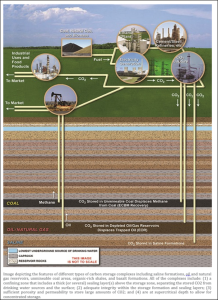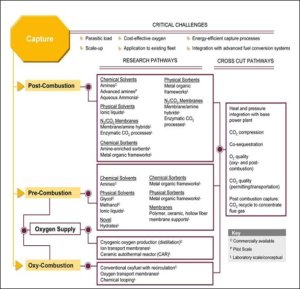TECHNOLOGIES
The phrase “clean coal” refers to a wide range of methods and technologies that are meant to reduce the environmental effects of coal use. As a quick introduction, the U.S. Energy Information Administration (EIA) summarized the various clean coal efforts in the U.S., as of December 2021:
“The coal industry has found several ways to reduce sulfur and other impurities from coal. The industry has also found more effective ways of cleaning coal after it is mined, and some coal consumers use low sulfur coal. Power plants use flue gas desulfurization equipment, also known as scrubbers, to clean sulfur from the smoke before it leaves their smokestacks. In addition, the coal industry and the U.S. government have cooperated to develop technologies that can remove impurities from coal or that can make coal more energy efficient, which reduces the amount of coal that is burned per unit of useful energy produced. Equipment intended mainly to reduce SO2, NOx, and particulate matter can also be used to reduce mercury emissions from some types of coal. Scientists are also working on new ways to reduce mercury emissions from coal-burning power plants. Research is underway to address emissions of CO2 from coal combustion. One method is carbon capture, which separates CO2 from emissions sources and recovers it in a concentrated stream. The CO2 can then be injected underground for permanent storage, or sequestration. Reuse and recycling can also reduce the environmental effects of coal production and use. Land that was previously used for coal mining can be reclaimed and used for airports, landfills, and golf courses. Waste products captured by scrubbers can be used to produce products such as cement and synthetic gypsum for wallboard.” [1]
Existing and Emerging Clean Coal Processes
CARBON CAPTURE, UTILIZATION, AND STORAGE (CCUS)
Reducing carbon dioxide (CO2) emissions has been a major concern worldwide for over two decades and continues to be a key focus area for clean coal research and development. The U.S. Department of Energy (DOE) launched its Carbon Capture and Storage program in 1997. [2]
As seen in the following illustration, with CCUS, CO2 is removed from the stacks of a coal (or other fossil fuel or biomass) power plant (or industrial site) and is then either compressed and transported to a site where it can be permanently sequestered deep underground, or, alternately, the captured CO2 is utilized as a product.

Source: U.S. Department of Energy [3]
CCUS includes three technology focus areas: carbon capture; carbon transport and storage; and carbon utilization.
CARBON CAPTURE TECHNOLOGIES
There are three different approaches to CO2 capture: post-combustion, pre-combustion, and oxy-combustion systems. The following DOE figure illustrates each, noting challenges, as well as established and developmental technologies.

Source: U.S. Department of Energy [4]
Access a more detailed DOE discussion on these CO2 capture approaches here.
CO2 TRANSPORT AND GEOLOGIC STORAGE
In the U.S., captured carbon is transported via pipeline. The U.S. currently has approximately 5,300 miles of CO2 pipeline [5], but much more will be needed to reach the Nation’s goal of net-zero emissions by 2050. [6]. The impact of this infrastructure on communities is a key consideration and landowner and community opposition poses a significant challenge. [xx] Pipeline safety is also a key focus area. The Pipeline and Hazardous Materials Safety Administration of the U.S. Department of Transportation is responsible for CO2 pipeline safety.
After transport, captured CO2 is injected deep underground for permanent storage, often referred to as geologic sequestration. [7] The U.S. Department of Energy is investigating five types of underground formations for geologic carbon storage:
- Saline formations
- Oil and natural gas reservoirs
- Unmineable coal seams
- Organic-rich shales
- Basalt formations [8]
Access a more detailed DOE discussion on these CO2 storage approaches here.
In the U.S. and Canada, the Regional Carbon Sequestration Partnerships (RCSP) program determines the most suitable technologies, regulations, and infrastructure for carbon capture, transport, and storage in each region. [9] For details, see the May 2022 RCSP Factsheet. With carbon storage technologies, safety and permanence are key concerns. In the U.S., the process of CO2 injection and storage is regulated at the federal level by the Environmental Protection Agency. Individual states also regulate underground CO2 injection. [10]
CO2 UTILIZATION
Other technologies are being used or researched that enable the utilization of captured CO2, either directly, or by transforming it into various products. Direct use examples are in the food and beverage industry, the fertilizer industry, and in the oil and gas industry, where CO2 is used for enhanced oil recovery (EOR). There are issues with some utilization applications. With EOR, CO2 is being used to produce more oil, enabling more use of fossil fuels. And, in some indirect use applications, the transformation process can be very energy intense, so the use of low emission energy is deemed critical for it to be considered a clean coal process. [11]
The Global CO2 Initiative at the University of Michigan reports potential market demand for CO2 in the manufacture of these product clusters:
- Algae (processed separately to create biofuels or food additives)
- Building materials (for conversion to carbonates or infusion of CO2 into materials)
- Chemical intermediates (such as methanol, syngas, formic acid, and malic acid)
- Fuels (mainly for methane and alcohol)
- Novel materials (such as carbon fiber)
- Polymers (e.g., polycarbonates, polyurethane and PHA) [12]
For CO2 utilization for treated construction materials, see a recent University of Michigan report here.
For methane production, CO2 is injected into deep, unmineable coal seams, where it is adsorbed to displace methane. This coal seam methane is effectively natural gas, said to be an increasingly important new energy source. [13]
In another example, engineers at Stanford University are working on a process to convert captured CO2 into carbon-neutral fuels, as described here.
OTHER CLEAN COAL TECHNOLOGIES
Aside from CCUS, there are many other technologies that fall under the umbrella of clean coal, as described below.
- High-Efficiency Low-Emission (HELE) Coal Plants
HELE plants are supercritical and ultra-supercritical coal-fired plants that operate at higher temperatures and pressures than subcritical plants, which enables them to produce a greater amount of energy from each individual unit of coal. [14]
- Coal Gasification
Coal gasification is considered a cleaner option than coal combustion. Gasification uses gasifier reactors to convert diverse types of coal into clean synthesis gas to enable the low-cost production of electricity, transportation fuels, chemicals, hydrogen, and other useful products. [15] Underground coal gasification (UCG) could take advantage of large amounts of unmineable coal in the U.S. With UCG, the underground coal seam itself becomes the reactor, so that the gasification of the coal takes place underground instead of in a gasification vessel at the surface. UCG saves the cost and dangers of mining the coal. [16] Additionally, gasification of coal through biological conversion processes has been considered for both above and underground coal. This approach uses natural or introduced microorganisms, to break down in situ coal into simpler compounds, methane, and other gases, which can then be extracted via wells. [17]
In the U.S., gasification R&D has remained mostly in the private sector. [18]
- Integrated Gasification Combined Cycle
In IGCC technology, coal, water, and oxygen are fed to a gasifier, which turns the coal into syngas, which is then cleaned of particulates and sulfur compounds and fed to a gas turbine. The hot exhaust of the gas turbine and heat recovered from the process are routed through a heat-recovery generator to produce steam, which drives a steam turbine to produce electricity. [19] This process results in lower emissions of sulfur dioxide, particulates, and mercury, along with improved efficiency compared to conventional pulverized coal. [20]
- Flue Gas Desulfurization/Scrubbing
Coal power plants use flue gas desulfurization (FGD) equipment, aka scrubbers, to clean sulfur from the smoke before it leaves smokestacks. FGD reduces sulfur dioxide emissions by up to 97%, depending on the level of sulfur in the coal source and the extent of the reduction. Today scrubbers are widely used in developed countries. [21] Plants use electrostatic precipitators or baghouses (fabric filters) to remove particulates, like fly ash, and heavy metals from smoke. The equipment designed to reduce SO2, NOx, and particulate matter can also be used to reduce mercury emissions from some types of coal. Waste products captured by scrubbers can be used to produce products such as cement and synthetic gypsum. [22]
- Low-NOx Burners
Low-NOx burners allow coal-fired plants to reduce nitrogen oxide emissions. This technology adjusts combustion methods [23], resulting in reduced NOx emissions by up to 40 percent. Coupling low-NOx burners with reburning techniques and selective catalytic reduction can result in further reductions in NOx emissions. [24]
- Ultra-clean coal
Ultra-clean coal (UCC) refers to coal that has been subjected to new processing technologies which reduce ash below 0.25% and sulfur to very low levels. This means that pulverized coal might be used as fuel for very large marine engines, in place of heavy fuel oil. [25]
Updated November 2022, Tina Allen

Comments are closed.